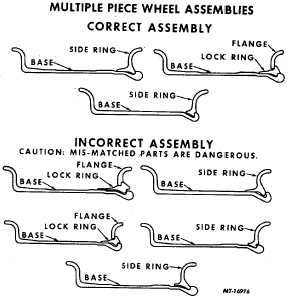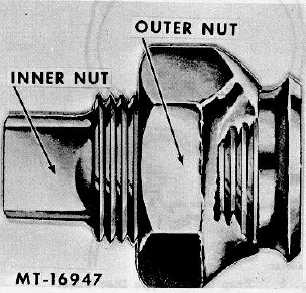|
| |
TRUCK SERVICE MANUAL
TM 5-4210-230-14&P-1
WHEELS, RIMS, TIRES
Multiple Piece Rims
On multiple piece rims if it is determined during
periodic inspection or during tire changes, that a part is
defective it must be replaced.
Caution must be observed when selecting the proper
replacement part, an incorrect fit is dangerous. (See Incorrect
Assembly Fig. 5). The side ring, locking ring and base must
all fit correctly as illustrated in Figure 5 under Correct
Assembly.
MULTIPLE PIECE WHEEL ASSEMBLIES
CORRECT ASSEMBLY
Fig. 5
ALUMINUM WHEELS
Care and Maintenance
Aluminum wheels should be periodically inspected both
on the vehicle and during tire changes for cracks, loose wheel
studs, worn mounting holes or being bent.
When checking cap nuts on dual disc wheels, back off
outer nut before attempting to tighten inner nut.
Whenever a tire is removed, clean off all grease and
road dirt. Use a wire brush or steel wool to remove the rubber
from the bead seat.
Projections on the side wall of the gutter may cause
uneven seating of the side ring and lead to chipping of the
gutter. Remove these and other projections in the mounting
area to assure the best possible fits.
Nicks and gouges in the vicinity of the fixed flange may
lead to rim fracture.
NOTE: Do not heat or weld wheels in an attempt to
straighten or repair severe road damage. The special alloy
used in these wheels is heat-treated, and uncontrolled heating
from welding torch affects the properties of the material.
To avoid possible corrosive affects to aluminum
wheels, use only a slight amount of water and neutral soap
(similar to Ivory Snow, Dreft, etc. no detergents) when
mounting tires. Do not use commercial rubber lubricants.
Wheel Installation
When installing aluminum wheels, lubricate stud
threads using a petroleum base grease containing colloidal
graphite. Be certain end of wheel wrench is smooth as it will
tear grooves in the wheel around the stud nuts it if is rough.
NOTE: Do not allow dirt to enter the mounting area
during installation. See "TORQUE CHART" for correct torque
values.
Wheel Studs and Mounting Nuts
Maintaining wheel stud and mounting nut tightness
does much to insure safe and satisfactory wheel operation.
Loose wheel mounting can cause vibration, shimmy, tire
wear, stud breakage, worn studs, mounting nuts (Fig. 6) and
worn or elongated stud holes (Fig. 7). Parts with these
characteristics must be replaced. Always keep wheel stud
nuts tightened to specified torque.
Fig. 6
CTS-2032N Page 2
PRINTED IN UNITED STATES OF AMERICA
|


